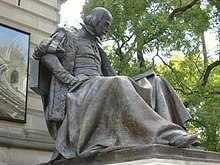Carnegie Museums of Pittsburgh are four museums that are operated by the Carnegie Institute headquartered in the Carnegie Institute complex in Oakland neighborhood of Pittsburgh, Pennsylvania. The Carnegie Institute complex that includes the original museum, music hall, and library was added to the National Register of Historic Places on March 30, 1979.
Portfolio

Two of the Carnegie museums, the Carnegie Museum of Natural History and the Carnegie Museum of Art, are both located in the Carnegie Institute and Library complex in Oakland, a landmark building listed on the National Register of Historic Places (ref #79002158, added 1979) that also houses the Carnegie Music Hall and the main branch of the Carnegie Library of Pittsburgh. The other two museums, The Andy Warhol Museum and the Carnegie Science Center, are located in separate facilities on Pittsburgh's North Shore.
Andy Warhol Museum

Opened on May 15, 1994, the Andy Warhol Museum is the largest museum in the world dedicated to one artist. The museum's collection includes over 4,000 Warhol art works in all media - paintings, drawings, prints, photographs, sculptures, and installation; the entire Andy Warhol Video Collection, 228 four minute Screen Tests, and 45 other films by Warhol; and extensive archives, most notably Warhol's Time Capsules. While dedicated to Andy Warhol, the museum also hosts many exhibits by artists who push the boundaries of art, just as Warhol did.
Carnegie Museum of Art

When Andrew Carnegie envisioned a museum collection consisting of the "Old Masters of tomorrow", the Carnegie Museum of Art became, arguably, the first museum of modern art in the United States. Founded in 1895, today it continues Carnegie's love of contemporary art by staging the Carnegie International every few years. Numerous significant works from the Internationals have been acquired for museum's permanent collection including Winslow Homer's The Wreck (1896) and James A. McNeill Whistler's Arrangement in Black: Portrait of Señor Pablo de Sarasate (1884). The marble Hall of Sculpture replicates the interior of the Parthenon. The Hall of Architecture contains the largest collection of plaster casts of architectural masterpieces in America and one of the three largest in the world. The Heinz Architectural Center, opened as part of the museum in 1993, is dedicated to the collection, study, and exhibition of architectural drawings and models. In 2001 the museum acquired the archive of African-American photographer Charles "Teenie" Harris, consisting of approximately 80,000 photographic negatives spanning from the 1930s to the 1970s. Many of these images have been catalogued and digitized and are available online via the Carnegie Museum of Art Collections Search.
The museum's permanent collection includes European and American decorative arts from the late seventeenth century to the present, works on paper, paintings, prints (notably Japanese prints), sculptures and installations.
Carnegie Museum of Natural History

From the discovery of Diplodocus carnegii to the most complete Tyrannosaurus rex known to date to a brand new, yet-to-be-named species of oviraptorosaur, Carnegie Museum of Natural History has one of the finest dinosaur collections in the world. Other exhibits include Hillman Hall of Minerals and Gems, Alcoa Foundation Hall of American Indians, Polar World: Wyckoff Hall of Arctic Life, Walton Hall of Ancient Egypt, and Benedum Hall of Geology. The museum's Powdermill Nature Reserve was established in 1956 to serve as a field station for long-term studies of natural populations, and now forms the core of the museum's Center for Biodiversity and Ecosystems. Research teams including Carnegie scientists have made critical discoveries such as Puijila darwini, Castorocauda lutrasimilis, and Hadrocodium wui.
Carnegie Science Center
Opened in 1991, but with a history that dates to October 24, 1939, the Carnegie Science Center is the most visited museum in Pittsburgh. Among its attractions are the newly constructed Buhl Digital Dome (which features the latest in projection), the Rangos Omnimax Theater, SportsWorks, the Miniature Railroad & Village, and the USS Requin, a World War II submarine.
Under the leadership of Robert Wilburn, Buhl Science Center merged with the Carnegie Institute and a new $40 million Carnegie Science Center was constructed.
References
External links

- Carnegie Museums of Pittsburgh
- Andy Warhol Museum
- Carnegie Museum of Art
- Carnegie Museum of Natural History
- Carnegie Science Center
- Powdermill Nature Reserve
- National Register of Historic Places
Video
- WQED onQ: On A Grand Scale: Carnegie Hall of Architecture
- WQED onQ: Dinosaurs in their Time
